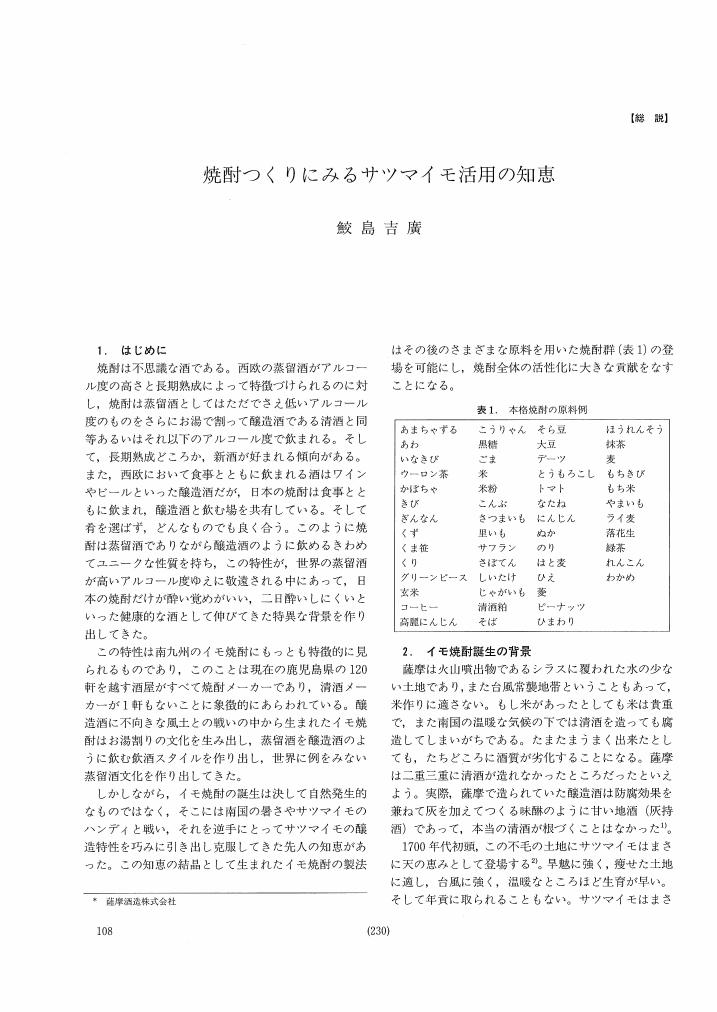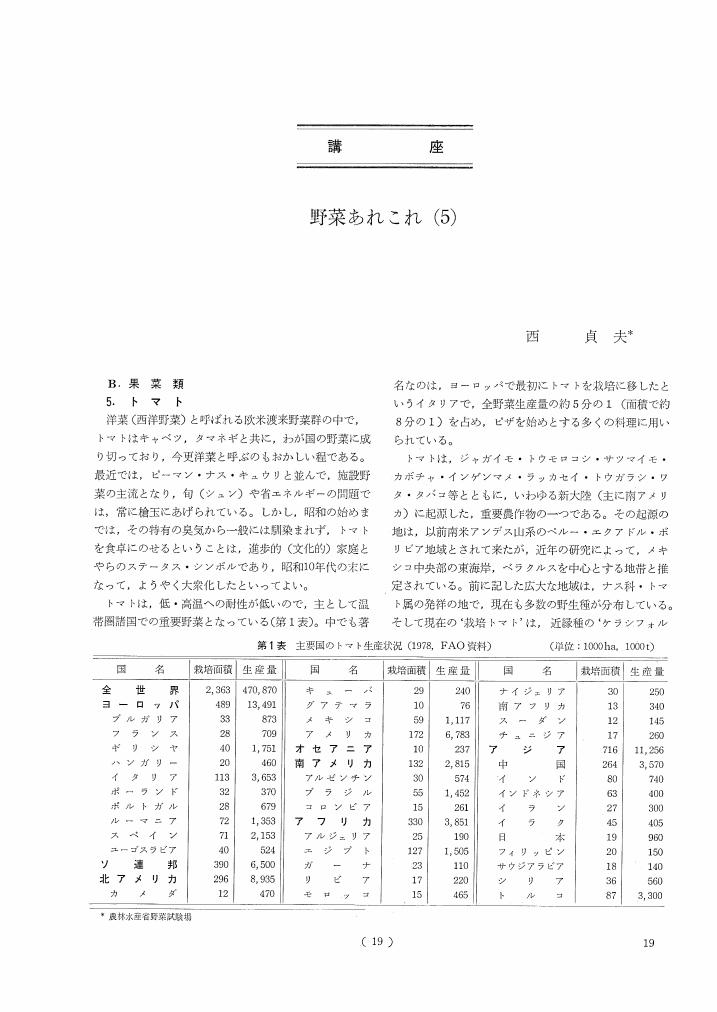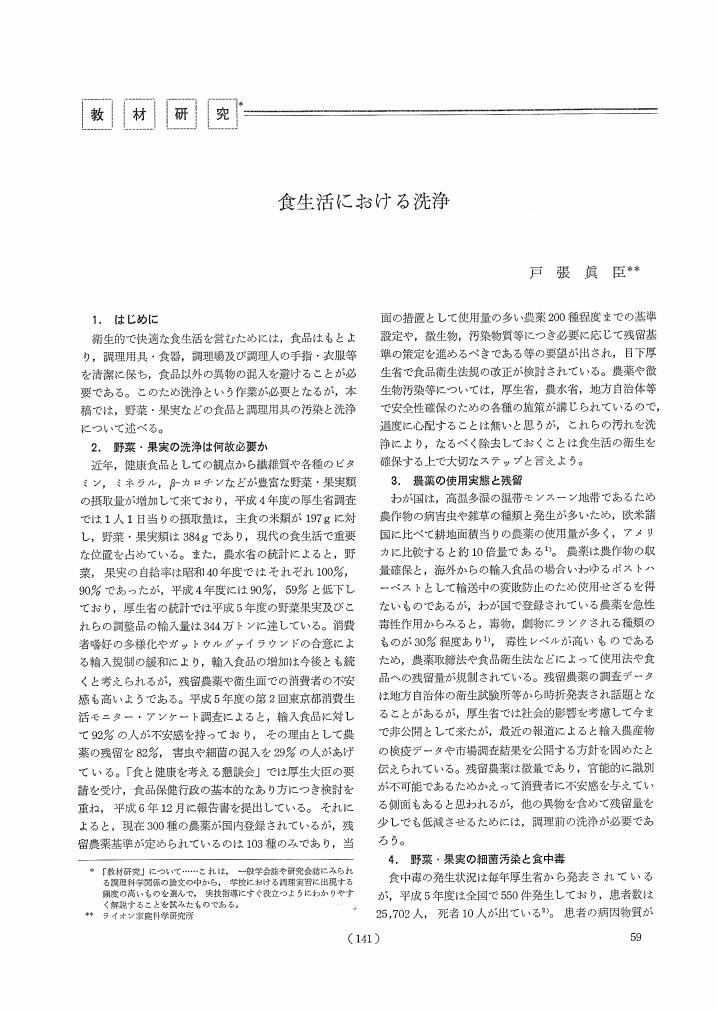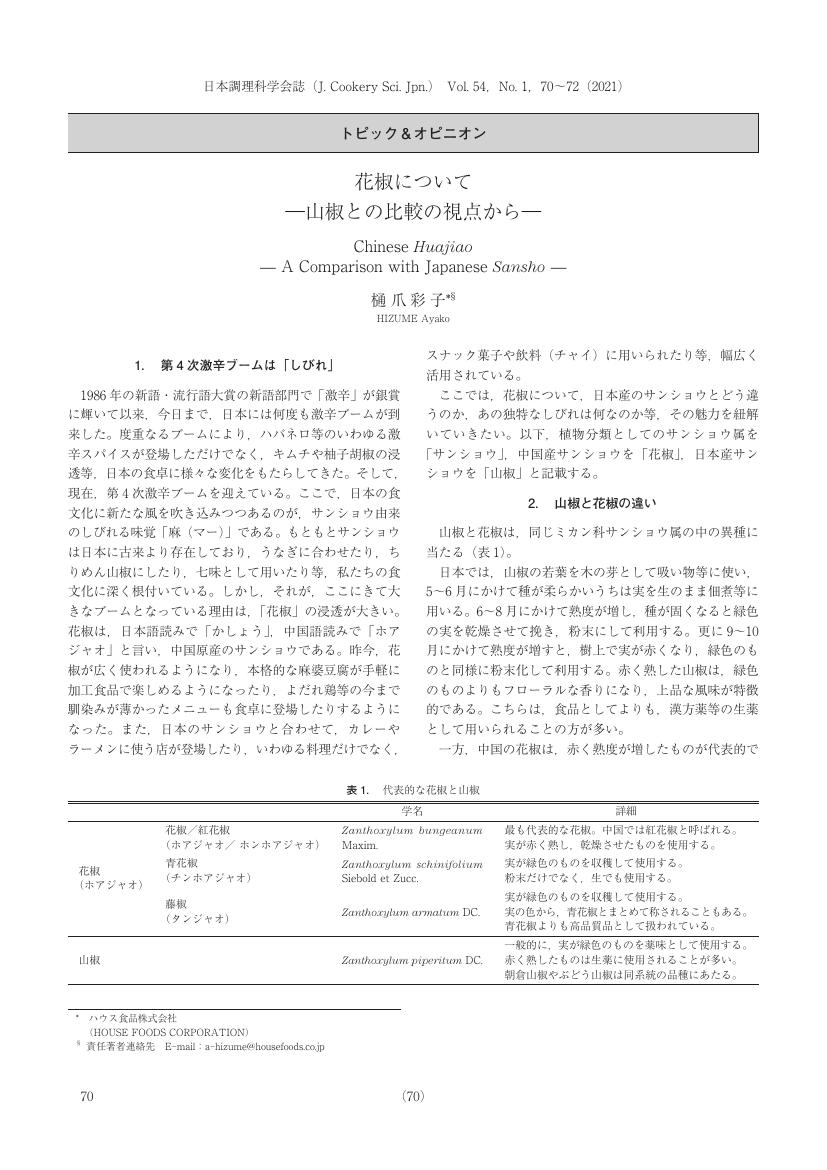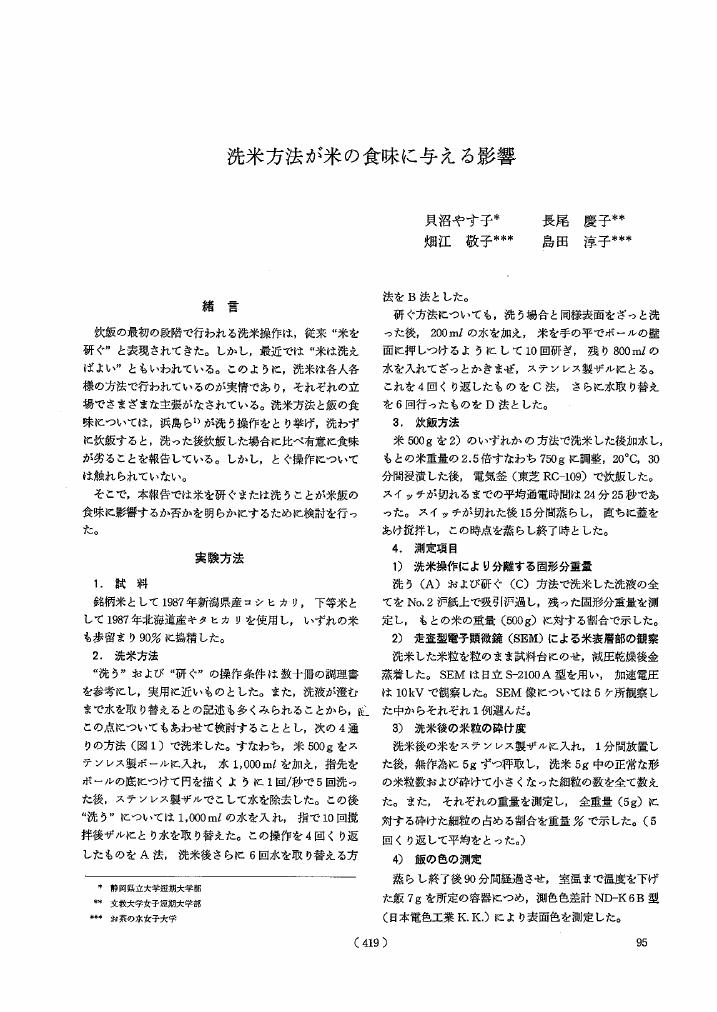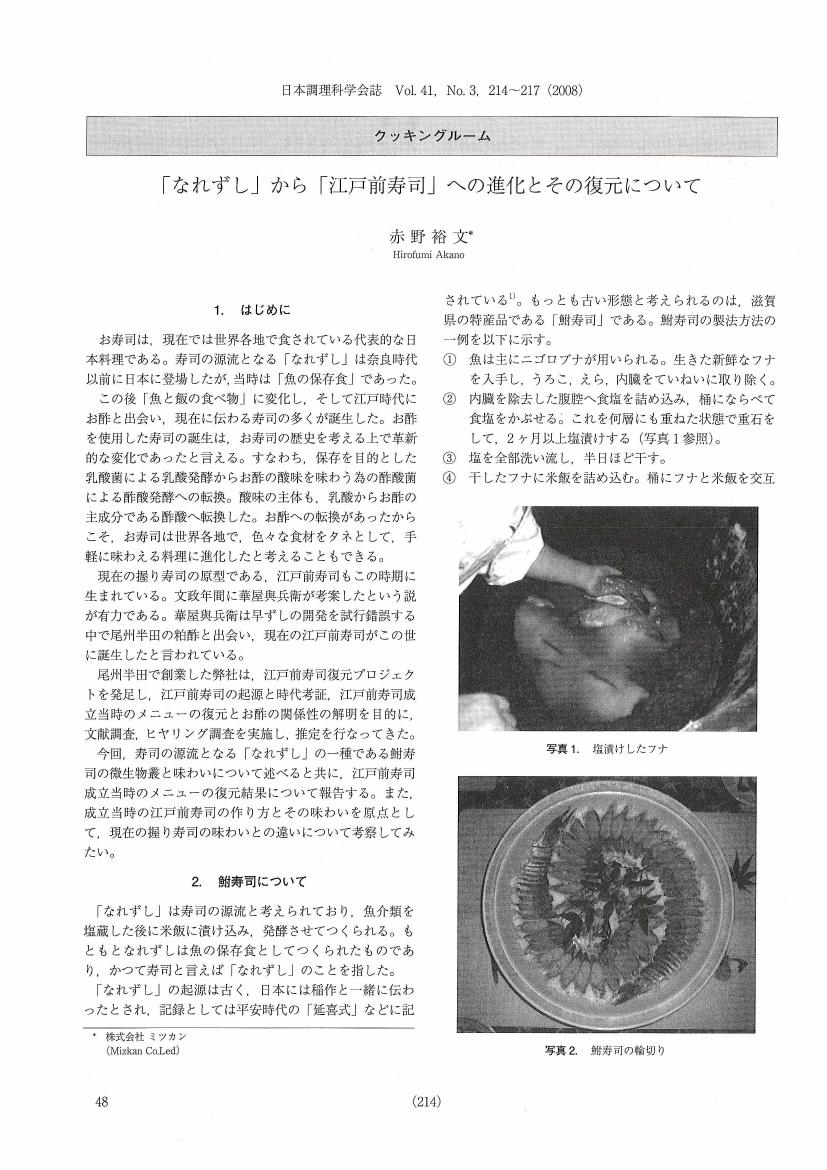2 0 0 0 OA 焼酎つくりにみるサツマイモ活用の知恵
- 著者
- 鮫島 吉廣
- 出版者
- 一般社団法人 日本調理科学会
- 雑誌
- 日本調理科学会誌 (ISSN:13411535)
- 巻号頁・発行日
- vol.34, no.2, pp.230-235, 2001-05-20 (Released:2013-04-26)
- 参考文献数
- 23
2 0 0 0 OA 鯉料理と山形
- 著者
- 富江 ハス子
- 出版者
- 一般社団法人 日本調理科学会
- 雑誌
- 調理科学 (ISSN:09105360)
- 巻号頁・発行日
- vol.18, no.2, pp.109-113, 1985-07-20 (Released:2013-04-26)
- 参考文献数
- 5
- 被引用文献数
- 1
2 0 0 0 OA 各種製茶の煎出条件とカフェイン・タンニン溶出量及び味との関係
- 著者
- 米田 泰子 加藤 佐千子
- 出版者
- 一般社団法人 日本調理科学会
- 雑誌
- 調理科学 (ISSN:09105360)
- 巻号頁・発行日
- vol.27, no.1, pp.31-38, 1994-02-20 (Released:2013-04-26)
- 参考文献数
- 11
- 被引用文献数
- 4
In order to discover the correlation between the concentration of caffeine and tannin released by brewing tea and the result of the palatability, as for gyokuro, sencha, mizudasisencha, hojicha, bancha, oolong-tea, we brewed each tea three times and measured the amounts of caffeine and tannin in each different brewing period.1. Gyokuro; The second infusion exuded more caffeine and tannin when it was steeped for 0.5,1,2,3 minutes. And the first infusion exuded more when it was steeped 4 minutes. But in the palatability of each brewing tea there were little differences on the degree of bitterness and astringency. The total taste of the first infusion was the strongest and most preferred.2. Sencha; The second infusion exuded the most caffeine and tannin when it was steeped for 0.5,1 minute. The first infusion exuded them most when it was steeped for 3 or 4 minutes. The bitterness and astringency in the first infusion were as mush as the second infusion and in the third infusion were weaker. The more the tea was rebrewed the weaker the taste got.3. Hojicha, bancha; The first infusion exuded more caffeine and tannin (except 0.5,1 minutes steeped one), and the bitterness and astringency were stronger.4. Oolong-tea; As for the concentration of caffeine and tannin the result was the same as hojicha, bancha. The first infusion with the strongest total taste was not preferred. The second one seemed to be favoured.5. The lower quality teas have a positive correlation between the concentration of caffeine and tannin and bitterness, astringency, umami and popularity. Their tastes seem to be more affected by the concentration of caffeine and tannin. Oolong-tea has a negative correlation between the popularity and the concentration of caffeine and tannin.
2 0 0 0 OA 質量分析イメージングによるジャガイモ毒素の局在解析
- 著者
- 平 修 龍田 幸奈 片野 肇
- 出版者
- 一般社団法人 日本調理科学会
- 雑誌
- 日本調理科学会誌 (ISSN:13411535)
- 巻号頁・発行日
- vol.50, no.1, pp.20-24, 2017 (Released:2017-02-20)
- 参考文献数
- 13
2 0 0 0 OA 野菜あれこれ(5)
- 著者
- 西 貞夫
- 出版者
- 一般社団法人 日本調理科学会
- 雑誌
- 調理科学 (ISSN:09105360)
- 巻号頁・発行日
- vol.14, no.1, pp.19-26, 1981-02-20 (Released:2013-04-26)
2 0 0 0 OA 食品の嗜好に関する研究(第3報)
- 著者
- 高橋 史人 山口 和子
- 出版者
- 一般社団法人 日本調理科学会
- 雑誌
- 調理科学 (ISSN:09105360)
- 巻号頁・発行日
- vol.18, no.4, pp.259-268, 1985-12-20 (Released:2013-04-26)
- 参考文献数
- 6
- 被引用文献数
- 1
The authors have made investigation into about five thousands men and women aged above twelve all over Japan in 1978,1980 and 1982 in order to find structures of food preference.The investigation was made by self-writing method to evaluate individual preference on about one hundred fifty kinds of dishes and foods, and thirty four kinds of strength of taste and type of textures. For preference on dishes and food, five-point scale was adopted. On the contrary, paired choice was adopted for strength of taste and type of texture.Two papers in terms of this study were already published. Main results of this paper are as follows.(1) The largest factor which affects food preference is age. And age characteristics have been analyzed by the common preference factors found in prior studies. Take teenagers for an example, their characteristics are dislike of “Japanese foods” and like of “Western and heavy foods”.(2) Area characteristics have been analyzed by the common preference factors. Take Kanto area for an example, its characteristics are “Western and spicy tastes”.(3) To find how food preference changes according to age, likes and dislikes of the common preference factors and of the forty-two foods composed of those factors were studied. For example, the foods of “Japanese” factor become prefered as age goes up, while the food of “Western” factor have the opposite tendency. The terning point of preference on the foods of “Japanese” factor is the thirties and that of “Western” factor is the forties.(4) The similarity among the area characteristics, of the food preference seen in the eight areas in Japan were found out. The food preference of Tohoku area is similar to that of Hokkaido, and so is Hokuriku to Tokai.
2 0 0 0 OA 食生活における洗浄
- 著者
- 戸張 眞臣
- 出版者
- 一般社団法人 日本調理科学会
- 雑誌
- 日本調理科学会誌 (ISSN:13411535)
- 巻号頁・発行日
- vol.28, no.2, pp.141-144, 1995-05-20 (Released:2013-04-26)
- 参考文献数
- 19
2 0 0 0 OA 電子レンジによる食品の調理に関する研究
- 著者
- 堀越 フサエ
- 出版者
- 一般社団法人 日本調理科学会
- 雑誌
- 調理科学 (ISSN:09105360)
- 巻号頁・発行日
- vol.4, no.3, pp.128-140, 1971-09-20 (Released:2013-04-26)
2 0 0 0 OA 究極の親子丼 ―特殊な能力を獲得したニワトリ―
- 著者
- 白石 純一
- 出版者
- 一般社団法人 日本調理科学会
- 雑誌
- 日本調理科学会誌 (ISSN:13411535)
- 巻号頁・発行日
- vol.46, no.3, pp.247-248, 2013 (Released:2013-08-20)
- 参考文献数
- 1
2 0 0 0 OA 花椒について ―山椒との比較の視点から―
- 著者
- 樋爪 彩子
- 出版者
- 一般社団法人 日本調理科学会
- 雑誌
- 日本調理科学会誌 (ISSN:13411535)
- 巻号頁・発行日
- vol.54, no.1, pp.70-72, 2021-02-05 (Released:2021-02-12)
- 参考文献数
- 7
- 被引用文献数
- 1
2 0 0 0 OA 洗米方法が米の食味に与える影響
- 著者
- 貝沼 やす子 長尾 慶子 畑江 敬子 島田 淳子
- 出版者
- 一般社団法人 日本調理科学会
- 雑誌
- 調理科学 (ISSN:09105360)
- 巻号頁・発行日
- vol.23, no.4, pp.419-423, 1990-11-20 (Released:2013-04-26)
- 参考文献数
- 3
- 被引用文献数
- 11
2 0 0 0 OA 豆鼓の諸成分
- 著者
- 角野 猛
- 出版者
- 一般社団法人 日本調理科学会
- 雑誌
- 日本調理科学会誌 (ISSN:13411535)
- 巻号頁・発行日
- vol.47, no.3, pp.183-186, 2014 (Released:2014-07-04)
- 参考文献数
- 13
2 0 0 0 OA 「アラキドン酸」による食品の美味しさ向上効果
- 著者
- 山口 進
- 出版者
- 一般社団法人 日本調理科学会
- 雑誌
- 日本調理科学会誌 (ISSN:13411535)
- 巻号頁・発行日
- vol.44, no.5, pp.317-322, 2011 (Released:2014-05-16)
- 参考文献数
- 20
- 著者
- 岡本 洋子 畦 五月 田口 田鶴子
- 出版者
- 一般社団法人 日本調理科学会
- 雑誌
- 日本調理科学会誌 (ISSN:13411535)
- 巻号頁・発行日
- vol.33, no.2, pp.166-177, 2000-05-20 (Released:2013-04-26)
- 参考文献数
- 11
We investigated the effect of the eating behavior of infants on their taste sensitivity and development. The study was carried out on a total of 130 children between the ages of one and three years (74 males and 56 females in the age range from 18 months to 41 months) who were enrolled at three approved nursery schools in the prefecture of Okayama. The study involved observing the eating habits at mealtimes in households according to Enjoji's Developmental Questionnaire for Infants, and using flavored aqueous solutions for evaluating taste sensitivity. At least half the children lived in households in which they were provided with home-cooked food and were able to enjoy eating while taking with their family during the meal. The majority of the children in this study were sensitive to sweet, sour and salty tastes within a range of concentration of 0.2-0.8% for an aqueous sucrose solution,0.02-0.06% for an aqueous citric acid solution, and 0.04-0.16% for an aqueous sodium chloride solution. We did not observe any statistical correlation between the eating situation and taste sensitivity of the children, except in the case of sensitivity to a salty taste. However, there existed a significant correlation between the eating situation and the development of the children in four to five categories among the total of six categories. It was clear that a healthy eating situation in infancy did play a positive role in development (for example, in such areas as basic habits, language formation and language comprehension). The results indicate that eating patterns in the household during the early stages of infancy did not have a significant effect on taste sensitivity, except for a salty taste, but suggest that there may have been some effect on the children's development.
2 0 0 0 OA 手延素麺
- 著者
- 小川 玄吾
- 出版者
- 一般社団法人 日本調理科学会
- 雑誌
- 調理科学 (ISSN:09105360)
- 巻号頁・発行日
- vol.18, no.1, pp.11-16, 1985-03-20 (Released:2013-04-26)
- 参考文献数
- 12
- 被引用文献数
- 1
2 0 0 0 OA 「なれずし」から「江戸前寿司」への進化とその復元について
- 著者
- 赤野 裕文
- 出版者
- 一般社団法人 日本調理科学会
- 雑誌
- 日本調理科学会誌 (ISSN:13411535)
- 巻号頁・発行日
- vol.41, no.3, pp.214-217, 2008-06-20 (Released:2013-04-26)
- 参考文献数
- 3
2 0 0 0 OA チョコレート油脂の結晶科学
- 著者
- 本同 宏成
- 出版者
- 一般社団法人 日本調理科学会
- 雑誌
- 日本調理科学会誌 (ISSN:13411535)
- 巻号頁・発行日
- vol.53, no.3, pp.216-219, 2020-06-05 (Released:2020-06-12)
- 参考文献数
- 11
- 被引用文献数
- 1
- 著者
- 日本調理科学会近畿支部 焼く分科会
- 出版者
- 一般社団法人 日本調理科学会
- 雑誌
- 日本調理科学会誌 (ISSN:13411535)
- 巻号頁・発行日
- vol.44, no.6, pp.400-406, 2011 (Released:2014-04-25)
- 参考文献数
- 15
過熱水蒸気で焼成した製品の特徴を明らかにするために,家庭用過熱水蒸気オーブンの過熱水蒸気機能とオーブン機能を用いて,低温加熱(150°C)と高温加熱(250°C)でハンバーグの焼成を行った。試料内部温度が75°Cになるまで焼成を行った。加熱初期の温度上昇速度は,過熱水蒸気では低温加熱は高温加熱と同様に速かった。製品重量や製品から採取した肉汁量は焼成温度の違いによる差はなかった。官能評価において,低温加熱の方が焼き色は薄く(p<0.001),香ばしい香りは弱く(p<0.01),総合評価は悪かった(p<0.01)。しかし,ジューシーさと脂っぽさは差がなかった。このことから,過熱水蒸気の低温加熱は,加熱時間を長く要する料理に向いていると考えられる。
2 0 0 0 OA 味噌の調理
- 著者
- 伊東 清枝
- 出版者
- 一般社団法人 日本調理科学会
- 雑誌
- 調理科学 (ISSN:09105360)
- 巻号頁・発行日
- vol.1, no.2, pp.75-79, 1968-07-25 (Released:2013-04-26)
- 参考文献数
- 10
2 0 0 0 OA 凍豆腐
- 著者
- 田村 正紀
- 出版者
- 一般社団法人 日本調理科学会
- 雑誌
- 日本調理科学会誌 (ISSN:13411535)
- 巻号頁・発行日
- vol.28, no.2, pp.114-122, 1995-05-20 (Released:2013-04-26)
- 参考文献数
- 16
